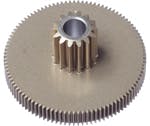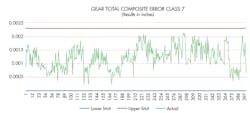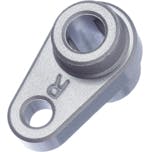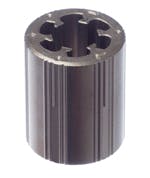Sinter Hardened Metal: The Economical Alternative to Machining
Download this article as a .PDF
According to the Metal Powder Industries Federation (MPIF) Standard 35, sinter hardening is quench hardening during the cooling cycle of the sintering furnace. Accelerated cooling is applied to the part to achieve a microstructure optimized for strength and improved tolerance capabilities. While conventional sintering requires regulation of time, temperature, and atmosphere within the sintering furnace, sinter hardening further requires careful regulation of the cooling curve to yield the desired physical and mechanical properties.
That is the technical definition of sinter hardening, but the part designers need to know is that sinter hardening offers some compelling engineering advantages. It eliminates the time, cost, and potential for defects that come with a separate heat treating step. During sinter hardening, components are quenched in the sintering atmosphere instead of a traditional oil quench, rendering the part surface clean and free of oil residue.
This atmospheric quench is preferred over conventional oil quench heat treatment to optimize form and dimensional control, since warpage and distortion can be an issue with oil bath quenches. Since sinter hardened parts can be manufactured to net-shape or near-net-shape, this alternative to a secondary heat treatment provides a strong economic incentive.
Sinter hardened parts are routinely produced with fine features. It is common for the company to utilize this method on complex parts with tight dimensional requirements including gears and structural components used in power transmissions and household appliances, to name a few common applications. Many complex components could not be produced using any other metal manufacturing method other than the sinter hardening process —at least not cost-effectively, reliably, or with repeatability.
The case examples described below examine three components manufactured at Atlas, which have been co-designed with their customers, to take full advantage of the benefits of sinter hardening, and the utilization of this process results in repeatable, precise manufacturing and economically priced components.
Precision Gears Drive Automotive Applications
Gearing is a classic application for powder metal with the added benefit of offering the ability to create complex gear forms that cannot cost-effectively be achieved with machining. For a recent example, consider a compound gear manufactured for use within an automotive electric motor. The gear shown in Fig. 1 is produced to American Gear Manufacturers Association (AGMA) level 7 quality standards. This gear combines 101- and 14-tooth gearing in a single net-shape component. Aside from the disparity in the number of teeth, the individual gears have a 3 to 1 differential in their face depth and outside diameters.
From a manufacturing standpoint, the component requires complex, multi-level tooling to produce the gear forms. Additionally, the features on this gear are very fine; the tips of the smaller gear teeth measure between 300 and 500 µm across—or about the same distance spanned by three to five particles.
On a piece-price basis, the design and ability to have it sourced as a sintered metal component offers significant cost savings over the machined alternative originally considered.
The gears, having an AGMA level 7 requirement, have very tight tolerances. Run-out specification is 0.00267 inch (0.068 mm) max, while the part’s overall length has to be held within ±0.00196 inch (0.05 mm). As shown in Fig. 2, the total composite error for these parts demonstrates consistent statistical results between the lower and upper limits.
As discussed in the introduction, it is a challenge to minimize or eliminate the warpage or distortion tendency when components are processed with a conventional oil quench heat treatment due to thermal gradients in the oil bath. Hardening sintered metal components in the sintering furnace utilizes a chemically driven heat treatment method, reducing the risk of distortion associated with a secondary heat-treating operation. With sinter hardening versus conventional quench and temper, dimensional variance can improve by as much as 50%.
Another manufacturing requirement of this gear was driven by the customer’s expectations for an AGMA 7 gear—the objectives for volume, tolerance, and avoidance of part-on-part contact, required to automate the material handling process. This “no human hands” approach, which integrates molding through packaging, eliminates multiple handling steps, while the choice to sinter harden in the furnace saves two time-consuming transports to and from a secondary heat treatment provider.
Appliance Cam Gets Stronger
Powder metal processes often have significant advantages over other manufacturing methods; net-shape capabilities typically drive dramatic cost implications. A new cam for an appliance hinge was no exception. In this second example, the component, which supports a 50-lb. load for a washing machine lid, has geometric features that would render it expensive to manufacture on a repeatable basis in high volumes using other processes, such as machining, welding or broaching. The key requirements of the part seen in Fig. 3 are a countersink into a bore and unequal hub lengths while maintaining balanced density, all while keeping an eye on cost, lend itself to the powder metal process.
Multi-level compaction capability produces the cam as a net-shape component that requires no additional processing other than plating prior to shipping. As a result, the powder metal part costs approximately 66% less than a comparable part made from other manufacturing technologies.
In addition to geometry and cost, a sinter hardened material is preferred in this instance because the part does not require a burn-off cycle in preparation for the plating process. The cam design is similar to an earlier component produced in a common iron copper alloy. However, an update to the appliance changed the lid from stamped metal to glass, and as a result, the tensile load requirements on the cam needed to be increased. The original iron copper part simply was not designed for the additional weight.
Typical iron copper alloy supports a yield strength of 50 ksi/ (340MPa), while a sinter hardened iron chromium pre-alloyed powder supports a yield strength of 120 ksi/ (830MPa) in this application. Additionally, using sinter hardened material eliminates the requirement for a secondary heat treatment process, which adds cost and process time. The combination of material selection and manufacturing strategy enables the manufacturing of a precision part that satisfies the application’s volume and economic requirements.
Cylindrical Housing Requires Intricate Core Features
In the third example, a small cylindrical housing with strength, cleanliness, and economic requirements turns out to be another appropriate use for a sinter hardened material. The housing of the part seen in Fig. 4 has internal vein features that would be difficult to produce economically with other manufacturing methods.
The housing requires a ribbed flange die to create the fine detail on the component’s exterior. There, the die has a fixed-fill feature that creates a ribbed pattern on the outside diameter, which serves as a visual aid to orient the part for the assembly process. On the interior, the core pin creates all the interior vein details.
The tips of the veins that outline the interior pockets have the same thickness as five metal powder particles, or 500 µm. Since milling and electrical discharge machining (EDM) cannot be applied cost-effectively given the high production volumes for this part, powder metal became the method of choice for the customer.
In the initial design, stock material with a traditional lubricant package was chosen for the component’s strength and wear requirements, but the density requirements in combination with the vein details required modifications to the material blend. The housing is now manufactured using a sinter hardened material primarily to avoid the potential for distortion from a secondary heat treating application.
However, a proprietary lubricant blended with this material further boosts manufacturing feasibility by supporting part integrity throughout the compaction cycle and allowing for an increased cycle time. With careful tool design, the selection of the appropriate material and the addition of a precise lubricant for ejection, the part meet the application’s requirements—and ultimately, the customer’s.
Advantages of Sinter Hardened Metals
After examining the three sinter hardening case examples, the advantages of the process can be summed up by the following:
Cost: Net-shape or near-net shape, achievable with precise tooling and selected manufacturing methods, gives sintered metal components significant cost advantages over machined alternatives.
Cleanliness: Sinter hardened parts are free of contaminants because there is no residual oil, while heat treated oil quenched parts may require a cleaning operation.
Efficiency: Sinter hardening saves time, cost, and movement versus sourcing a secondary heat treating process.
Tolerance: Sinter hardened materials provide reduced distortion and variation, thereby improving the overall tolerance of the component.
Joe Pfingstler is the technical sales manager for Atlas Pressed Metals in DuBois, Pa.





